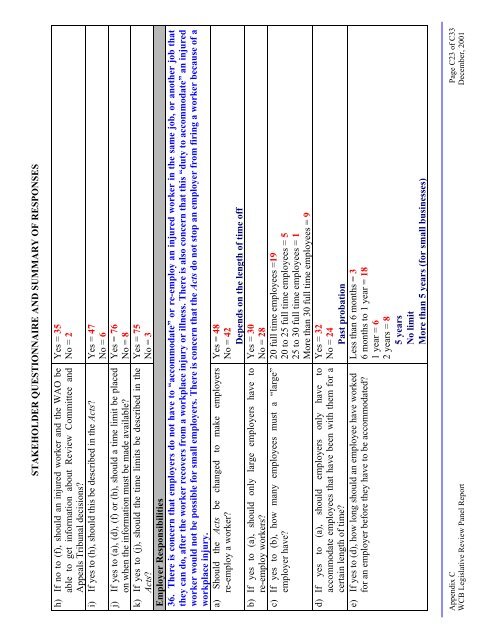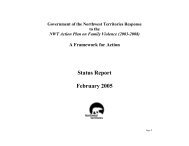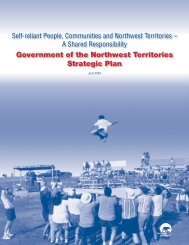Act Now - The Report of the WCB Legislative Review Panel to the
Act Now - The Report of the WCB Legislative Review Panel to the
Act Now - The Report of the WCB Legislative Review Panel to the
- No tags were found...
You also want an ePaper? Increase the reach of your titles
YUMPU automatically turns print PDFs into web optimized ePapers that Google loves.
STAKEHOLDER QUESTIONNAIRE AND SUMMARY OF RESPONSESh) If no <strong>to</strong> (f), should an injured worker and <strong>the</strong> WAO beable <strong>to</strong> get information about <strong>Review</strong> Committee andAppeals Tribunal decisions?Yes = 35No = 2i) If yes <strong>to</strong> (h), should this be described in <strong>the</strong> <strong>Act</strong>s? Yes = 47No = 6j) If yes <strong>to</strong> (a), (d), (f) or (h), should a time limit be placedon when <strong>the</strong> information must be made available?k) If yes <strong>to</strong> (j), should <strong>the</strong> time limits be described in <strong>the</strong><strong>Act</strong>s?Yes = 76No = 8Yes = 75No = 3Employer Responsibilities36. <strong>The</strong>re is concern that employers do not have <strong>to</strong> “accommodate” or re-employ an injured worker in <strong>the</strong> same job, or ano<strong>the</strong>r job that<strong>the</strong>y can do, after <strong>the</strong> worker recovers from a workplace injury or illness. <strong>The</strong>re is also concern that this “duty <strong>to</strong> accommodate” an injuredworker would not be possible for small employers. <strong>The</strong>re is concern that <strong>the</strong> <strong>Act</strong>s do not s<strong>to</strong>p an employer from firing a worker because <strong>of</strong> aworkplace injury.a) Should<strong>the</strong> <strong>Act</strong>s be changed <strong>to</strong> make employersre-employ a worker?b) If yes <strong>to</strong> (a), should only large employers have <strong>to</strong>re-employ workers?c) If yes <strong>to</strong> (b), how many employees must a “large”employer have?d) Ifyes <strong>to</strong> (a), should employers only have <strong>to</strong>accommodate employees that have been with <strong>the</strong>m for acertain length <strong>of</strong> time?e) If yes <strong>to</strong> (d), how long should an employee have workedfor an employer before <strong>the</strong>y have <strong>to</strong> be accommodated?Yes = 48No = 42 Depends on <strong>the</strong> length <strong>of</strong> time <strong>of</strong>fYes = 30No = 2820 full time employees =1920 <strong>to</strong> 25 full time employees = 525 <strong>to</strong> 30 full time employees = 1More than 30 full time employees = 9Yes = 32No = 24 Past probationLess than 6 months = 36 months <strong>to</strong> 1 year = 181 year = 62 years = 8 5 years No limit More than 5 years (for small businesses)Appendix C Page C23 <strong>of</strong> C33<strong>WCB</strong> <strong>Legislative</strong> <strong>Review</strong> <strong>Panel</strong> <strong>Report</strong> December, 2001
















